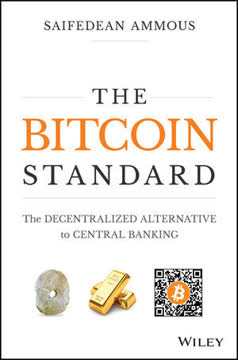Key Takeaways
1. Bitcoin: A Revolutionary Digital Currency Born from Financial Crisis
"On October 31, 2008, 2:10 P.M., New York time. The several hundred members of an obscure mailing list comprising cryptography experts and enthusiasts receive an e-mail from somebody calling himself Satoshi Nakamoto."
Origins in financial turmoil. Bitcoin emerged in the aftermath of the 2008 financial crisis, created by the pseudonymous Satoshi Nakamoto. The cryptocurrency was designed as a decentralized alternative to traditional financial systems, aiming to remove the need for intermediaries like banks and governments.
Key features and philosophy:
- Peer-to-peer transactions without central authority
- Limited supply (21 million bitcoins)
- Transparent and immutable transaction record
- Potential for financial inclusion and reduced transaction costs
Bitcoin's creation was driven by a desire to address the flaws exposed in the traditional financial system during the crisis, offering a new paradigm for currency and value transfer in the digital age.
2. The Blockchain: A Groundbreaking Public Ledger System
"The blockchain, the all-important ledger that functions as bitcoin's central nervous system, was Nakamoto's signature achievement."
Revolutionary record-keeping. The blockchain is a decentralized, public ledger that records all bitcoin transactions. This innovation solves the "double-spending" problem that had plagued previous digital currency attempts, ensuring the integrity of transactions without relying on a central authority.
Key aspects of the blockchain:
- Distributed across a network of computers
- Cryptographically secured and nearly impossible to alter
- Transparent and accessible to all participants
- Eliminates need for trusted third parties in transactions
The blockchain's potential extends beyond cryptocurrency, offering possibilities for secure, decentralized record-keeping in various industries, from finance to supply chain management.
3. Bitcoin's Community: From Cypherpunks to Mainstream Adopters
"We are all Satoshi."
Evolving ecosystem. Bitcoin's community has grown from a small group of cryptography enthusiasts to a diverse global network. This expansion has brought together various stakeholders, including developers, investors, entrepreneurs, and everyday users.
Key community developments:
- Early adopters: Cypherpunks and libertarian-minded technologists
- Growing pains: Debates over bitcoin's purpose and future direction
- Mainstream interest: Increasing adoption by businesses and investors
- Ongoing challenges: Balancing decentralization with regulation and scalability
The bitcoin community's growth reflects the technology's increasing relevance and the ongoing tension between its revolutionary ideals and the realities of mainstream adoption.
4. Mining: The Competitive Process of Creating New Bitcoins
"Mining is, to our mind, a misnomer. The essential work being done is more like bookkeeping."
Decentralized consensus mechanism. Bitcoin mining is the process by which new bitcoins are created and transactions are verified and added to the blockchain. Miners use powerful computers to solve complex mathematical problems, competing for the right to add new blocks to the chain.
Key aspects of mining:
- Proof-of-work system ensures network security
- Miners are rewarded with newly minted bitcoins
- Mining difficulty adjusts to maintain consistent block times
- Concerns over energy consumption and centralization of mining power
The mining process is crucial to bitcoin's operation, but it has also sparked debates about environmental impact and the concentration of mining power in the hands of a few large operations.
5. Volatility and Adoption: Bitcoin's Rollercoaster Journey
"The price went from $33 at the end of February to $230 on April 9, pushing bitcoin's total market capitalization through $1 billion for the first time, but also setting off one of the wildest yearlong rides that any financial asset has ever seen."
Price fluctuations and growing acceptance. Bitcoin's value has experienced extreme volatility since its inception, with dramatic price swings reflecting both speculative interest and growing adoption. This volatility has both attracted investors and hindered bitcoin's use as a stable currency.
Key factors influencing bitcoin's journey:
- Speculation and investment driving price movements
- Increasing merchant adoption and payment processor development
- High-profile events (e.g., Mt. Gox collapse) impacting public perception
- Ongoing debate over bitcoin's role as a currency vs. store of value
Despite its volatility, bitcoin has gained significant traction, with major companies beginning to accept it as payment and financial institutions exploring its potential.
6. Regulation Challenges: Governments Grapple with Cryptocurrencies
"Imagine the army of staff that the national finance ministry and central bank would command into action to stabilize the economy; imagine also the reinforcements of technical and financial support that would come from SWAT teams at the International Monetary Fund. Compare that to what these five men, two of them volunteers, were up against, and you get a sense of how very differently bitcoin's economy is structured."
Regulatory landscape evolves. Governments worldwide have struggled to develop coherent regulatory frameworks for cryptocurrencies. The decentralized nature of bitcoin poses unique challenges for traditional regulatory approaches.
Key regulatory issues:
- Anti-money laundering (AML) and know-your-customer (KYC) requirements
- Tax treatment of cryptocurrency transactions and gains
- Consumer protection concerns
- Balancing innovation with financial stability
The regulatory response to bitcoin varies globally, with some countries embracing it and others imposing restrictions. This patchwork of regulations creates both opportunities and challenges for the cryptocurrency ecosystem.
7. Bitcoin 2.0: Expanding Blockchain Technology Beyond Currency
"Smart contracts, a blockchain-based version of the popular crowdfunding model in which organizers pledge a certain amount when others' donations reach target levels."
Beyond digital cash. The blockchain technology underlying bitcoin has inspired a wave of innovation, with developers exploring its potential for applications beyond cryptocurrency. These "Bitcoin 2.0" projects aim to leverage the blockchain's decentralized, trustless nature for various purposes.
Key Bitcoin 2.0 concepts:
- Smart contracts: Self-executing agreements encoded on the blockchain
- Decentralized autonomous organizations (DAOs)
- Tokenization of assets and securities
- Blockchain-based voting systems and identity management
These innovations have the potential to disrupt various industries by reducing the need for intermediaries and enhancing transparency and efficiency.
8. Global Impact: Bitcoin's Potential to Empower the Unbanked
"Roughly 2.5 billion adults in the world don't have access to banks, which means somewhere in the order of 5 billion people belong to households that are cut off from a financial system that the rest of us take for granted."
Financial inclusion through cryptocurrency. Bitcoin and other cryptocurrencies have the potential to provide financial services to the unbanked population worldwide. By offering a decentralized financial system accessible via mobile devices, cryptocurrencies could overcome traditional barriers to banking.
Potential benefits for the unbanked:
- Access to savings and payment services
- Cheaper and faster international remittances
- Ability to participate in the global digital economy
- Protection against currency devaluation in unstable economies
While challenges remain, including technological barriers and regulatory hurdles, bitcoin's potential to empower the unbanked represents one of its most promising and impactful use cases.
9. Security and Trust: Overcoming Centralized System Vulnerabilities
"If a greedy attacker is able to assemble more CPU power than all the honest nodes, he would have to choose between using it to defraud people by stealing back his payments, or using it to generate new coins. He ought to find it more profitable to play by the rules, such rules that favour him with more new coins than everyone else combined, than to undermine the system and the validity of his own wealth."
Rethinking trust in digital transactions. Bitcoin's decentralized structure aims to eliminate the need for trusted third parties in financial transactions. This approach addresses vulnerabilities inherent in centralized systems, such as single points of failure and the potential for corruption.
Key security features and challenges:
- Cryptographic protection of transactions and wallets
- Distributed consensus mechanism resistant to attacks
- Potential vulnerabilities in exchanges and wallet services
- Ongoing debate over the "51% attack" scenario
While bitcoin's core protocol has proven resilient, security breaches at cryptocurrency exchanges and wallet services highlight the ongoing challenges in securing digital assets. The bitcoin ecosystem continues to evolve, balancing decentralization with the need for user-friendly and secure services.
Last updated:
FAQ
What's The Age of Cryptocurrency about?
- Exploration of Digital Currency: The book examines how Bitcoin and other cryptocurrencies are reshaping the global economic landscape, challenging traditional financial systems.
- Historical Context: It provides a historical overview of money, tracing its evolution from ancient systems to modern fiat currencies, to contextualize the rise of digital currencies.
- Technological and Societal Impact: The authors discuss the technological underpinnings of cryptocurrencies, such as blockchain, and their potential societal implications, including financial inclusion for the unbanked.
Why should I read The Age of Cryptocurrency?
- Understanding Financial Disruption: The book is essential for anyone interested in how cryptocurrencies could reshape the financial landscape and democratize finance.
- Comprehensive Overview: It offers a thorough understanding of cryptocurrencies, covering technical, economic, and social aspects, suitable for both newcomers and those familiar with the topic.
- Expert Insights: Written by seasoned journalists Paul Vigna and Michael J. Casey, it provides well-researched perspectives and interviews with key figures in the cryptocurrency space.
What are the key takeaways of The Age of Cryptocurrency?
- Decentralization of Trust: Cryptocurrencies offer a decentralized alternative to traditional banking, reducing reliance on centralized institutions and empowering individuals.
- Potential for Economic Change: They have the potential to bring billions of unbanked individuals into the global economy, altering how transactions are conducted.
- Challenges Ahead: The book addresses significant challenges, including regulatory hurdles, security concerns, and market volatility, crucial for anyone considering involvement in the cryptocurrency space.
How does Bitcoin work according to The Age of Cryptocurrency?
- Blockchain Technology: Bitcoin operates on a decentralized ledger called the blockchain, which records all transactions transparently and securely.
- Mining Process: Transactions are verified through mining, where computers solve complex problems to add new blocks to the blockchain, rewarding miners with bitcoins.
- Digital Wallets: Users store bitcoins in digital wallets, accessible via private keys, allowing for direct peer-to-peer transactions without intermediaries.
What is the significance of the term "trustless" in the context of Bitcoin?
- Elimination of Intermediaries: "Trustless" refers to conducting transactions without relying on a central authority, a fundamental principle of Bitcoin.
- Decentralized Verification: Transactions are verified by a network of computers, enhancing security and reducing fraud risk.
- Empowerment through Transparency: The trustless nature allows users to engage in transactions confidently, knowing the system's integrity is maintained by cryptographic protocols.
What are the risks associated with Bitcoin as discussed in The Age of Cryptocurrency?
- Security Vulnerabilities: Users face risks like hacking and theft, especially if they don't secure their digital wallets properly.
- Price Volatility: Bitcoin's extreme price fluctuations can deter its use as a stable currency, complicating everyday transactions.
- Regulatory Challenges: Uncertainty in how governments regulate cryptocurrencies can impact the market and future of Bitcoin.
How does The Age of Cryptocurrency address the future of money?
- Shift to Digital Currencies: The authors argue that digital currencies will play a central role in the future of money as technology evolves.
- Empowerment of Individuals: Cryptocurrencies can provide greater financial control, leading to a more inclusive system benefiting unbanked populations.
- Potential for Innovation: The rise of cryptocurrencies could spur further innovation in financial technology, enhancing transaction efficiency and accessibility.
How does The Age of Cryptocurrency compare Bitcoin to traditional banking systems?
- Centralized vs. Decentralized: Traditional banking is centralized, while Bitcoin operates on a decentralized network, reducing intermediary power.
- Cost Efficiency: Bitcoin can lower transaction costs by eliminating fees associated with banks and payment processors.
- Access and Inclusion: Bitcoin offers financial services to unbanked populations, providing inclusivity over conventional systems.
What role does community play in the success of Bitcoin as described in The Age of Cryptocurrency?
- Collective Effort: Bitcoin's success relies on a vibrant community of users, developers, and advocates contributing to its growth.
- Cultural Identity: The community has developed its own culture, fostering a sense of belonging and commitment among members.
- Philanthropy and Goodwill: Many in the community engage in philanthropic efforts, enhancing Bitcoin's reputation and encouraging acceptance.
What are the implications of Bitcoin for the global economy?
- Disruption of Traditional Finance: Bitcoin offers an alternative means of transactions, potentially leading to a reevaluation of money creation and management.
- Increased Financial Inclusion: By providing access to financial services for the unbanked, Bitcoin could drive economic growth in underserved regions.
- Challenges for Regulation: The rise of Bitcoin presents challenges for regulators balancing innovation with consumer protection.
What is the concept of smart contracts in the context of cryptocurrencies?
- Automated Agreements: Smart contracts are self-executing contracts with terms written into code, allowing automatic enforcement.
- Reduced Need for Intermediaries: They eliminate the need for lawyers and notaries, reducing costs and increasing efficiency.
- Blockchain Verification: Operating on blockchain technology, smart contracts ensure trust in execution without a central authority.
What future developments are anticipated for cryptocurrencies according to The Age of Cryptocurrency?
- Increased Adoption: As understanding and infrastructure improve, more businesses and individuals are expected to adopt cryptocurrencies.
- Technological Advancements: Innovations in blockchain technology are likely to enhance functionality and security.
- Regulatory Clarity: Clearer regulations may grant cryptocurrencies legitimacy and wider acceptance in the financial system.
Review Summary
The Age of Cryptocurrency is lauded as an accessible introduction to Bitcoin and blockchain technology. Readers appreciate its comprehensive coverage of cryptocurrency's history, potential impacts, and challenges. The book offers insights into the ideological roots, technical aspects, and social implications of digital currencies. While some found certain sections overly detailed or dated, many praise the balanced perspective and engaging narrative. The authors' exploration of cryptocurrency's potential to revolutionize finance and empower the unbanked resonated with readers. Overall, it's recommended as a solid foundation for understanding the evolving world of digital currencies.
Similar Books










Download PDF
Download EPUB
.epub digital book format is ideal for reading ebooks on phones, tablets, and e-readers.




